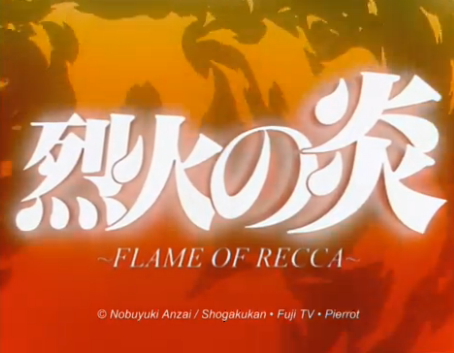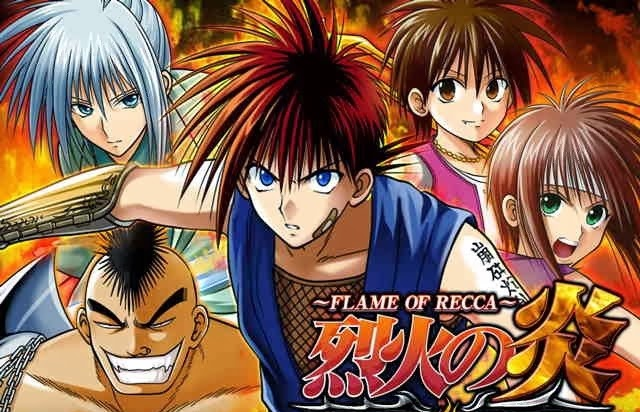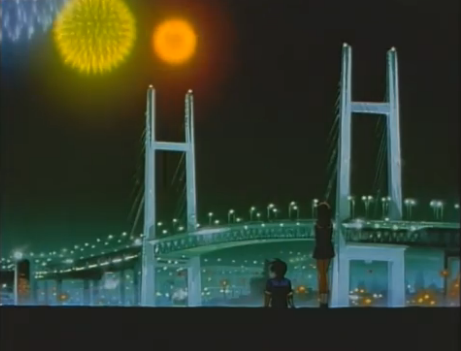03.14

Comic books and animation go hand in hand a lot of the time. While live action tends to have trouble handling a lot of the more imaginative and out there aspects of tales from the visual print medium, animation is always able to keep up. From superheroes, to outlandish comedy, space opera, the medium of animation has no problem giving the stories the visual realization they deserve.
But there are exceptions. Sometimes the result is immaculate, the animated version easily stacks up to and even surpasses the original work, such as in the case of anime classic, Trigun. There are also cases like the Yu Yu Hakusho anime which cuts off the jarring and rotten parts of the original manga and sands it down to be a much better and fleshed out work as a whole. In other cases, the result is a final product not even on par with the original, in fact missing much of the original’s appeal.
The shonen fantasy action manga, Flame of Recca by Nobuyuki Anzai, is in the last camp. One of Weekly Shonen Sunday’s most popular series and selling over 25 million copies, it was only natural that it would have gotten an animation adaption. However, years later, it is greatly regarded as the inferior version of Anzai’s story, though there is not much out there to explain why that is.
I will be covering its anime adaption in this series as a contrast to the original manga and where I feel it fails to match up. Though Flame of Recca is popular in manga circles, it is not so much in the anime world, and there is a good reason for that. First: the basics.

Volume #1
Flame of Recca was written by Nobuyuki Anzai for serialisation in Weekly Shonen Sunday magazine back in 1995. He had been working as an assistant on Kazuhiro Fujita’s magazine favorite Ushio & Tora and left to make it on his own. Flame of Recca, by all accounts, was a hit for Sunday running for 329 chapters and 33 volumes, and ending in 2002. The series had video games, an anime that ran from 1997 to 1998, and is still represented in Sunday events now.
Flame of Recca has clear inspiration from both Ushio & Tora (itself a manga that achieved incredible success despite taking 25 years to get a proper anime) and Yu Yu Hakusho (its weaving storyline clearly an inspiration from Yoshihiro Togashi’s shonen classic) all while having a flare of its own, no pun intended. FoR had great fight scenes, inventive action, good chemistry between characters, sharp art, a romance, and an adventure plotline that never strayed in its drive from chapter one to the end. Over 20 years later and it is still considered one of the best series to run in Shonen Sunday and is still looked at as Anzai’s best series to this day.
So you may have noticed the mention of it getting an anime and wondered how this article could exist. How could anyone mess up a shonen anime? After all, they were the bread and butter of the anime industry in the ‘90s (and are still the most popular genre now), so certainly something like this should have been easy to adapt. This doesn’t even factor in the fact that that anime was made by the same studio and director of the classic anime adaption of Yu Yu Haksuho not so long before FoR.
Well, this is where it differs from Ushio & Tora (which had no anime, yet had incredible success) and Yu Yu Hakusho (which got an incredible anime adaption that surpassed the popularity of the manga). FoR is not remembered for its anime except as a nostalgia piece, when anyone brings up FoR today it is usually because of the manga.
Why, you may ask?
The anime version of Flame of Recca is a disappointment for both fans of the manga and for those looking for a good shonen series in general.
How does it fail? Well, let’s be honest and say it’s not a total failure. It more or less follows the story of the manga, the music is great, the opening and ending themes are excellent and suit the series excellently, and it did give the manga a bit of a boost in popularity when it came out as most anime do. But as an adaption, it is generally accepted as a letdown.
This series of articles will start with episode one and work its way through the 42 episodes of the anime to discuss what exactly it does wrong and does right and compare it with the original manga. It will be a long ride, and probably won’t be interesting for those who detest old anime and manga, let alone shonen, but for the rest it might be a bit informative in how an adaption can stumble in translation or do right by the source material.
Before we get started, it would be best to focus on some general changes with the anime compared to the manga. This should help understand how it differs from the source right off the bat.
The first change: The color coding of the characters is changed between the anime and manga.

Manga

Anime
Some characters are changed in hair and eye color, and this happens with many characters in the series. This is a minor thing but it still stands as a change to bring up. The art style is also tweaked from its rougher early 90s tone to a softer late 90s feel.
The second change: You might have noticed Flame of Recca is 33 volumes long. That’s right; it’s 329 chapters of hot blooded shonen action that tells one complete story. You might have also noticed the anime is only 42 episodes long. How did they fit 329 chapters into 42 episodes? That’s easy enough to answer.
They didn’t.
The Flame of Recca anime truncates the first 16 volumes (less than half the series) into 42 episodes. It misses two very important arcs in the manga, cuts out characters and events, and some of this writer’s favorite material, to cut straight to the ending and missing a lot of the story growth in the process. It stands as an incomplete adaption– and even that which it adapted was tweaked, sometimes rather arbitrarily.
The third change: Personality tweaks. There are moments changed from the original manga that alter events to the point that they change character motivations and drives. This causes some weird inconsistencies that will have to be brought up when they come up in future entries.
After all this you might think the Flame of Recca anime is pure garbage that you should avoid as well as one of the worst adaptions of a popular work. It’s not. It’s merely a competent shonen anime that isn’t very well remembered now because it isn’t that well done. The manga, on the other hand, holds up really well for an older action series and is deserving of more attention. This series will attempt to explain why that is.
Next time, we will get into the nitty gritty as to the difference between the anime and the manga.
Stay tuned!
